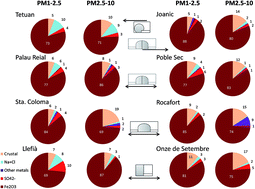Formation and alteration of airborne particles in the subway environment
Abstract
Most particles in the rail subway environment are sub-micron sized ferruginous flakes and splinters generated mechanically by frictional wear of brake pads, wheels and rails. To better understand the mechanisms of formation and the alteration processes affecting inhalable particles in subways, PM samples (1–2.5 μm and 2.5–10 μm) were collected in the Barcelona Metro and then studied under a scanning electron microscope. Most particles in these samples are hematitic (up to 88%), with relatively minor amounts of mineral matter (up to 9%) and sulphates (up to 5%). Detailed microscopy (using back scattered and TEM-DRX imaging) reveals how many of the metallic particles comprise the metallic Fe nucleus surrounded by hematite (Fe2O3) and a coating of sulphate and chloride salts mixed with mineral matter (including Ca-carbonates, clay minerals and quartz). These observations record the emission of fine to ultrafine FePM by frictional wear at elevated temperatures that promote rapid partial (or complete) oxidation of the native metal. Water condensing on the PM surface during cooling leads to the adsorption of inorganic mineral particles that coat the iron oxide. The distinctively layered polymineralic structure that results from these processes is peculiar to particles generated in the subway environment and very different from PM typically inhaled outdoors.



 Please wait while we load your content...
Please wait while we load your content...